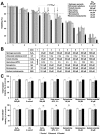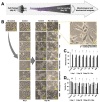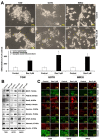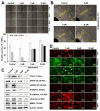Anti-stress, Glial- and Neuro-differentiation Potential of Resveratrol: Characterization by Cellular, Biochemical and Imaging Assays
- PMID: 32121454
- PMCID: PMC7146125
- DOI: 10.3390/nu12030671
Anti-stress, Glial- and Neuro-differentiation Potential of Resveratrol: Characterization by Cellular, Biochemical and Imaging Assays
Abstract
Environmental stress, exhaustive industrialization and the use of chemicals in our daily lives contribute to increasing incidence of cancer and other pathologies. Although the cancer treatment has revolutionized in last 2-3 decades, shortcomings such as (i) extremely high cost of treatment, (ii) poor availability of drugs, (iii) severe side effects and (iv) emergence of drug resistance have prioritized the need of developing alternate natural, economic and welfare (NEW) therapeutics reagents. Identification and characterization of such anti-stress NEW drugs that not only limit the growth of cancer cells but also reprogram them to perform their specific functions are highly desired. We recruited rat glioma- and human neuroblastoma-based assays to explore such activities of resveratrol, a naturally occurring stilbenoid. We demonstrate that nontoxic doses of resveratrol protect cells against a variety of stresses that are largely involved in age-related brain pathologies. These included oxidative, DNA damage, metal toxicity, heat, hypoxia, and protein aggregation stresses. Furthermore, it caused differentiation of cells to functional astrocytes and neurons as characterized by the upregulation of their specific protein markers. These findings endorse multiple bioactivities of resveratrol and encourage them to be tested for their benefits in animal models and humans.
Keywords: DNA damage; Oxidative stress; differentiation; hypoxia; old age; protection; protein aggregation; resveratrol.
Conflict of interest statement
The authors declare no conflicts of interest.
Figures








Similar articles
-
Resveratrol attenuates oxidative-induced DNA damage in C6 Glioma cells.Neurotoxicology. 2007 Jul;28(4):886-91. doi: 10.1016/j.neuro.2007.03.008. Epub 2007 Mar 31. Neurotoxicology. 2007. PMID: 17498806
-
Developmental Programming of the Metabolic Syndrome: Can We Reprogram with Resveratrol?Int J Mol Sci. 2018 Aug 31;19(9):2584. doi: 10.3390/ijms19092584. Int J Mol Sci. 2018. PMID: 30200293 Free PMC article. Review.
-
Rat Glioma Cell-Based Functional Characterization of Anti-Stress and Protein Deaggregation Activities in the Marine Carotenoids, Astaxanthin and Fucoxanthin.Mar Drugs. 2019 Mar 23;17(3):189. doi: 10.3390/md17030189. Mar Drugs. 2019. PMID: 30909572 Free PMC article.
-
Pre and post treatment with curcumin and resveratrol protects astrocytes after oxidative stress.Brain Res. 2018 Aug 1;1692:45-55. doi: 10.1016/j.brainres.2018.05.001. Epub 2018 May 2. Brain Res. 2018. PMID: 29729252
-
Resveratrol effects in oral cancer cells: a comprehensive review.Med Oncol. 2021 Jul 17;38(8):97. doi: 10.1007/s12032-021-01548-0. Med Oncol. 2021. PMID: 34273003 Review.
Cited by
-
Bioinformatics and Molecular Insights to Anti-Metastasis Activity of Triethylene Glycol Derivatives.Int J Mol Sci. 2020 Jul 30;21(15):5463. doi: 10.3390/ijms21155463. Int J Mol Sci. 2020. PMID: 32751717 Free PMC article.
References
-
- Weng M.W., Lee H.W., Park S.H., Hu Y., Wang H.T., Chen L.C., Rom W.N., Huang W.C., Lepor H., Wu X.R., et al. Aldehydes are the predominant forces inducing DNA damage and inhibiting DNA repair in tobacco smoke carcinogenesis. Proc. Natl. Acad. Sci. USA. 2018;115:E6152–E6161. doi: 10.1073/pnas.1804869115. - DOI - PMC - PubMed
MeSH terms
Substances
LinkOut - more resources
Full Text Sources
Medical

